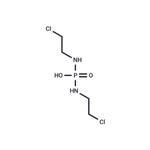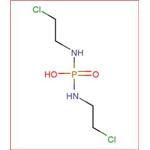Description
Palifosfamide is an active metabolite of the DNA alkylating agent ifosfamide. It is formed through hydroxylation of ifosfamide by various hepatic cytochrome P450 (CYP) isoforms. It is cytotoxic to L1210 and CCRF-CEM cancer cells when used at a concentration of 100 μM. Palifosfamide (100 mg/kg per day) reduces tumor growth in murine Lewis lung carcinoma and L1210 leukemia models, as well as a rat Yoshida ascitic sarcoma model.
Definition
ChEBI: Palifosfamide, also known as Isophosphamide mustard, is a type of phosphorodiamide. It is a proprietary stabilized metabolite of ifosfamide. Ifosfamide has been shown to be effective in high doses in treating testicular cancer, sarcoma and lymphoma.
in vitro
Palifosfamide lysine (ZIO-201) is a stable form of palifosfamide. It has broad activity in sarcoma lines in vitro. The IC50 ranges from 2.25 ro 6.75 μM for most cell lines except OS222 (IC50=31.5 μM).
in vivo
Tumor growth inhibition is seen in both OS31 and OS33 xenografts and the RMS xenograft resulting in a significant difference in event-free survival between the control and the treated groups. Differential gene expression of ALDH3A1 but not ALDH1A1 is noted in the OS31 xenograft. Stabilized palifosfamide administered to mice suppresses MX-1 tumor growth by greater than 80% with 17% complete antitumor responses. Oral bioavailability in rats is 48-73% of parenteral administration, and antitumor activity in mice is equivalent by both routes. Treatment with palifosfamide-tris combined with docetaxelor doxorubicin at optimal regimens results in complete tumor regression in 62-75% of mice.
Mode of action
Palifosfamide works by irreversibly alkylating and cross-linking DNA through GC base pairs, leading to 7-atom inter-strand cross-links that cannot be repaired. Its cytotoxic effect primarily stems from its ability to cross-link strands of DNA and RNA, inhibit protein synthesis, and block DNA replication, ultimately causing cell death. Unlike ifosfamide, this agent is not metabolized to acrolein or chloroacetaldehyde, metabolites associated with bladder and CNS toxicities.



